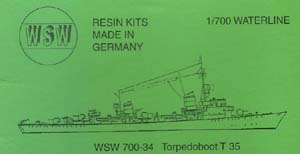WSW Resin 1/700 German Torpedoboot T 35 |  | Introduction I was delighted the other day when our sample of the WSW 1/700 Torpedoboot T 35 came in the mail from Rocky Mountain Shipyard. This German company makes a fine line of waterline resin ship kits. This is my first experience with WSW products and it will surely not be my last. I just love the lines of these rakish and deadly little German ships. Read on. The History To keep up with the Royal Navy's extensive program of building small fast torpedo boats, the Germans responded with a building program of their own. The first torpedobootes were not well suited to anything but coastal or light sea conditions. The ships built in WWI and just after were used alongside the battle fleet as a method for massed torpedo attacks on larger ships. Right after WWI, the design changed to almost a small destroyer with armament besides torpedoes included. This again changed just before WWII with designs for just torpedo use. The Fleet Torpedo Boats built during the war reverted again to the small destroyer concept with abilities to lay mines, attack landing craft or for full-scale attacks on larger ships. These later vessels could be considered destroyers in other nation's navies. The T.22 "1939 Period" Class After the unsuccessful Torpedoboote 1935 and 1937 classes a radical change in German torpedo boat design took place. Unlike their predecessors, which were focused on torpedo attacks, the new class of Fleet torpedo boats were multi purpose ships, usable for torpedo attacks, anti-aircraft defense and escort duty. This new design could almost be considered a small destroyer or a frigate class. These were among the largest German vessels to be termed Torpedo Boats. They were distinguishable by their large superstructure mounted far forward. Several ships survived WW 2 and served in the French or Russian navy until the 1950s. T 35 The "1939 period" Class T 35 was commissioned Oct.7, 1944 to join the 5th Torpedoboot-flotilla. She was presented as war reparation to United Kingdom on July 6, 1945. She was then transferred to the US Navy July 11, 1945 and renamed DD 965 and used for testing. She was then transferred to France in 1947 where she was used for parts. The Kit This kit comes molded in a light gray resin, with a one-piece waterline hull, many small parts – some on runners and some on wafers, separate guns, and a nice fret of PE. The hull is very well done with very little evidence of pinholes. Other things that immediately struck me were the castings of the guns and masts. The guns are one-piece castings with scale thin barrels for all calibers. The masts are scale thin and very well done. I don't know how WSW does it as many ships of this scale give you rod to cut into for the gun barrels and the like. A small wafer contains upper decks, platforms, gun tubes, and what appear to be life rafts. The wafer itself is transparently thin which should ease part separation and cleanup. The deck pieces have scale thin splinter shields throughout. The wafer appears perfect with no pinholes. One small bag contains the ships guns separated as to type. From the main guns down to the quad mount 20mms these are the best-molded resin parts I have encountered. All guns are complete as molded and are ready to mount with little or no cleanup! Gun shields are provided in PE. Another bag contains several separated runners of parts. Ship's cranes, davits, and boats are very well done. The ships boats and two sets of torpedo tubes have some cleanup issues but should not present any major problems. The single 20mm mounts, ship's lights, and masts are perfect and ready to go. A nice fret of PE contains railings, gun shields, mast parts and other details. The metal seems cleanly done and easy to separate. The ship railings seem a tad large for the scale but I plan on using them. A small paper set of printed flags is a nice touch. They appear sharp and in register. Instructions are basic, with little more than a few drawings and some basic painting instructions. They do a good job of identifying kit parts. You'll probably want to pick up some additional references on this ship anyway, so the limited information presented here shouldn't be too much of a hindrance. No decals are included with the kit. Conclusion I am pleased with this little kit. It contains enough detailed parts to build up to a great representation of this class of German ship. I would recommend this to the average to advanced ship modeler due to the vast array of small parts and PE railings. I can't wait to start building now! My thanks to Lisa Norman of the company formerly known as The Rocky Mountain Shipyard for the review sample. | 






|
